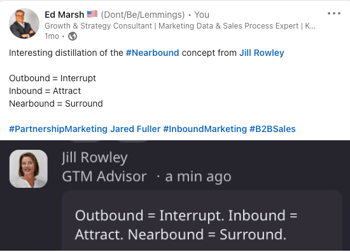Everyone Values Referral Leads - Let's Create More with a Nearbound Approach
Introduction to SignalsFromTheOP
Guide to Episode
- As buyers evolve, so must sales and marketing - from outbound to inbound to nearbound
- Partnership marketing is like a program for referral sales, at scale
- Partner marketing and sales help gain access and facilitate sales success
- Industrial OEMs can find many creative partnership opportunities that they've traditionally overlooked
Transcript follows:
Hello. I’m Ed Marsh. Thanks for joining me for this episode of my biweekly video blog – Signals From the OP. If you hear something original and thought-provoking, I’d urge you to share it with any industrial execs you know who might also appreciate it.
Nearbound - The Natural Evolution of Outbound and Inbound Marketing & Sales
Let’s talk about partnership marketing and the new buzz term that’s being used for it “Nearbound.”
 Jill Rowley, the sales phenom who put Marketo on the map, offers an interesting distillation of Nearbound marketing and sales.
Jill Rowley, the sales phenom who put Marketo on the map, offers an interesting distillation of Nearbound marketing and sales.
She puts it this way.
Outbound marketing = interrupting people.
Inbound marketing = attracting people.
Nearbound marketing = surrounding people.
Nearbound marketing is a fancy term for partnership marketing, but one that considers the challenges of marketing and selling today. I won’t run through the full litany of things you already know well about how markets are changing – suffice it to say, it's harder:
- To get to the table for meetings with buyers
- To move a full buying team to a decision
- To connect with buyers who work in the shadows
You know all of that and more.
So yes, you have content marketing to attract prospects as part of your manufacturing marketing program.
You’ve got activity expectations for your sales team for outbound prospecting and perhaps some outbound marketing like LinkedIn ads.
And still……it’s hard. It’s hard because everyone’s too busy for anything beyond crises. So how do you consistently grow? How do you get in front of people with creative ideas and for conversations about things they don’t necessarily need and definitely don’t want to spend time or probably money working on?
What types of lead generation effectively generate legitimate leads with a high likelihood of turning into sales opportunities?
That’s the huge question facing companies today – and that’s the foundational concept of partnership marketing.
Partnership Marketing - Referrals at Scale
The premise of partner marketing is that your prospects are already working with other trusted and non-competitive vendors. They have commercial relationships. They have established trust.
Partner marketing and sales coopt those established relationships to help you reach prospects, cutting through the noise, and arriving as a business resource bearing the imprimatur of value provided by your association with other vendors they trust. In other words, you’ll get a couple of seconds to establish your value as opposed to being completely ignored.
That’s important.
It gives your marketing and sales the opportunity to do what they do well, and they get opportunities to do less frequently than ever. Partner marketing works because it’s an acknowledgment of the fact that everyone’s too busy, has too many priorities, and not enough resources.
So when one of a company's trusted vendors says, “Hey, I know you’re busy, but I think you may find some value in the XYZ that ABC company does. They’ve helped others of my clients to (value proposition here.”) people will listen.
Partnership Marketing is All Around You
You’ve probably bought through partner marketing. Microsoft and Google sell the majority of their Office & G-Suite, respectively, through partners. You probably handle medical referrals from your PCP differently than if you start from scratch looking for a physician on your own. And your financial advisor may ask you establish a brokerage account at their preferred broker to facilitate your work.
As partner marketing matures, it extends beyond logos on a website and simple mentions.
Collaborative Sales, Marketing and Success
Often partner companies will create shared collateral. Sales and success teams will be trained to identify opportunities and make warm introductions. They may create content and events together – like webinars, case studies, and open houses. And often, there’s a sharing of insights by the sales teams who have an inside track on what’s happening.
That’s what Jill Rowley means by surrounding people. With a warm, referral-type introduction, your sales team will have access.
As they have access, prospects will engage with your marketing materials.
And as prospects are weighing their decision, worried about making a mistake as the JOLT effect explores, your partner’s sales team will be there to reassure them.
It all makes sense, particularly as other types of lead generation become less effective.
But it’s hard for industrial companies to visualize how it works in their context.
First, that’s not the way they’re accustomed to selling. Second, they tend to look very narrowly at their products and therefore have a tough time identifying possible partners.
So look beyond your products. Think about how Rockwell and Allen Bradley are a partnership marketing example you’re familiar with. Think about other OEMs, and companies that provide related services (maybe compressed air, safety equipment, factory talent recruiting, retention benefits, improved lighting, material handling, and of course, digitization tools like AR and machine monitoring.)
Well designed partnership marketing strategies extend your reach. It’s potentially awkward to start, but it’s a proven method. Give it a shot and see what nearbound leads might do for your company.
I’m Ed Marsh. Thank you for joining me for this episode of Signals from the OP. If you enjoyed it, please share it and subscribe – either to my YouTube channel EdMarshSpeaks.TV or at the related blog SignalsFromTheOP.com.


